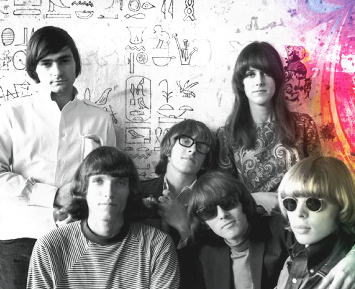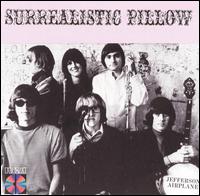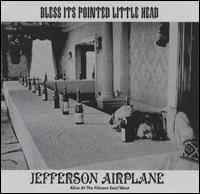|

The group formed on the West Coast of the USA during the summer of 1965 in what was called the San
Francisco Bay folk boom. Singer Marty Balin recruited another folk musician, Paul Kantner (born March 17, 1941, San Francisco), blues guitarist Jorma Kaukonen, jazz and folk vocalist Signe Toly Anderson, drummer Jerry Peloquin, and acoustic bassist Bob Harvey. They drew inspiration from groups such as the Beatles, the Byrds, and The Lovin' Spoonful, and built a local following at the Matrix Club.
The group made its first public appearance August 13, 1965 at The Matrix club in San Francisco. Peloquin was a seasoned
musician whose disdain for the others' drug use was a factor in his departure just a few weeks after the group began its career.
Skip Spence then took the drum chair. The band gradually developed a more electric sound that led to Harvey's replacement by Kaukonen's
childhood friend, Jack Casady, in October 1965. Later in 1965, they signed to RCA and recorded an album for release the following year called Jefferson Airplane Takes Off. Folk music very much influenced the group's debut album, which included staples such as John D. Loudermilk's "Tobacco Road" and Dino Valente's "Let's Get Together," as well as original group ballads like "It's No Secret" and "Come Up the Years."
In 1966, Spence was replaced by jazz drummer Spencer Dryden and Anderson by singer Grace Slick, formerly of another San Francisco group, The Great Society. Amongst their fans, the group's name was often shortened to "the Airplane". Slick brought with her a
powerful and supple contralto voice, well suited to the group's amplified psychedelic music, as well as a number of
important compositions, including "White Rabbit" (which Grace wrote) and "Somebody to Love" (written by Grace's brother-in-law, Great Society guitarist Darby Slick).
Their transition from local to national notoriety was engendered by their appearance at the epochal Monterey International Pop Festival in June 1967. Monterey showcased leading bands from several major music 'scenes' including New York,
San Francisco, Los Angeles, and England and the resulting TV and film coverage gave national (and international) exposure
to groups that had previously had only regional fame. All these bands were also greatly assisted by appearances on nationally
syndicated TV shows such The Ed Sullivan Show, which were videotaped in color and augmented by recent developments in video techniques. The Airplane's famous appearance
on the Sullivan show, performing "White Rabbit", has been frequently re-screened and is notable for its pioneering use of
the Chroma key process to simulate the Airplane's customary psychedelic light show.
Membership remained stable until 1970, by which time they had recorded five more albums. The
first of these, Surrealistic Pillow (1967), included two classic tracks, "White Rabbit" (inspired by the psychedelic drug LSD, then extremely popular in San Francisco, Maurice Ravel's Bolero, and Lewis Carroll's Alice in Wonderland), and the rousing anthem "Somebody to Love", as well as a reminder of their earlier folk incarnation, Kaukonen's solo acoustic guitar tour de force, "Embryonic
Journey", which referenced contemporary acoustic guitar masters such as John Fahey and helped to establish the popular genre exemplified by acoustic guitarist Leo Kottke. The album was extremely successful, reaching #3 in the US album charts, and alongside Sgt. Pepper's Lonely Hearts Club Band and The Doors' debut album, it is widely regarded as one of the seminal albums of the so-called "Summer Of Love".
The name Surrealistic Pillow was suggested by the "shadow" producer of the album, Jerry Garcia, when he mentioned that, as a whole, the album sounded "as Surrealistic as a pillow". The record company would not allow
Garcia's considerable contributions to the album to garner him a "Producer" credit, so Garcia is listed in the album's credits
as "spiritual advisor".
The band dived deeper into acid rock with 1967's After Bathing at Baxter's, an album of long multi-part suites, which demonstrated the group's proficiency with psychedelic rock. Its famous cover features a whimsical re-imagining of the group's Haight-Ashbury house as a Heath Robinson-inspired flying machine, drawn by artist and cartoonist Ron Cobb. Crown Of Creation (1968) was a transitionary record, more structured than its predecessor. The album's notable tracks include Grace Slick's
"Lather," said to be about drummer Spencer Dryden, with whom she was rumored to be having an affair, "Triad," a David Crosby
song that had been rejected by his group, the Byrds, because they deemed its subject matter, a mènage á trois, to be
objectionable, and the searing sex and drug anthem "Greasy Heart." In 1968 Jefferson Airplane unleashed Bless Its Pointed Little Head, which captured their live concert sound at the Fillmore and the Fillmore East. In the aftermath of the demise of the San Francisco scene, the band released Volunteers (1969), their most political venture. The title track, "We Can Be Together", "Good Shepherd", and the post-apocalyptic
"Wooden Ships" were all highlights. ("Wooden Ships," which Paul Kantner co-wrote with David Crosby and Stephen Stills, was recorded both by Jefferson Airplane and Crosby, Stills & Nash. As both groups released the song the same year and as it was co-written by members of both bands, both versions are considered
to be an original version of the song.)
The band performed in an early "morning maniac music" slot at the Woodstock festival in August 1969. In December that year, they played at the infamous free concert held at the Altamont
speedway in California. The concert, which was headlined by The Rolling Stones and also featured The Grateful Dead, was marred by crowd violence—Marty Balin was knocked out during a scuffle with Hells Angels
members who had been hired to act as "security". The event became notorious for the now-famous "Gimme Shelter Incident" due
to the death of black teenager Meredith Hunter, who was fatally stabbed in front of the stage by Hells Angels "guards" after allegedly pulling out a revolver during the
Stones' performance (this incident was the centerpiece of the documentary film Gimme Shelter).
Although the band released its first greatest-hits album, The Worst of Jefferson Airplane, in 1970, its only new
songs that year were two tracks available only on the single, "Mexico" b/w "Have You Seen the Saucers." The A-side was a staunch
criticism of President Richard Nixon's Operation Intercept which had been implemented to curtail the flow of marijuana into the United States, while the B-side marked the beginning
of a science-fiction obsession that Paul Kantner would explore with his music over the rest of the decade.
Balin and Dryden left the group shortly after the release of the single. The group continued on without them, releasing
Bark (whose cover featured a dead fish wrapped in an A&P-style grocery bag) in 1971 and Long John Silver
(whose cover folded into a humidor, presumably for the storage of marijuana) in 1972. Both albums were releaesd on the band's
own label, Grunt, which would continue to be distributed by RCA. The group replaced Dryden with drummer Joey Covington (who
also provided the vocals on the 1971 single, "Pretty as You Feel", from Bark). The legendary Afro-American blues fiddler
"Papa John" Creach (1917-1994) also joined the group in the early seventies.
During this time, Kaukonen and Casady began a side project they named Hot Tuna, in which the two of them, often supported by a fluid group of other musicians, began exploring traditional blues. They released
the acoustic Hot Tuna in 1970 and the electric First Pull Up-Then Pull Down in 1971. As time went by, Kaukonen
and Casady began devoting more of their attention to Hot Tuna and less of it to the Airplane. (In the song, "Third Week in
the Chelsea," from Bark, Kaukonen details the thoughts he is having about leaving the band.)
Jefferson Airplane's second live album Thirty Seconds Over Winterland (1973) is now best remembered for its cover
art, featuring a squadron of flying toasters, which the band later alleged to have spawned the famous "After Dark" computer screensaver design. In 1974, a collection of leftovers (singles and B-sides, including
"Mexico" and "Have You Seen the Saucers", as well as other non-album material) was released as Early Flight, the last
official Jefferson Airplane album
|
 |
|






cover artwork from various
phases of Jefferson Airplane's
existence
artist of the week
Tuesday, June 14, 2005
an overview of the Airplane
The Turbulent Flight of
Jefferson Airplane
you'll find excerpts from
Jeff Tarmakin's book as
well as lots of stuff that
didn't make it to the
printed version.
the official website
Airplane - related photographs,
interviews, discography, timeline,
articles and memorabilia
|
 |
|
|
 |
|
|
|

